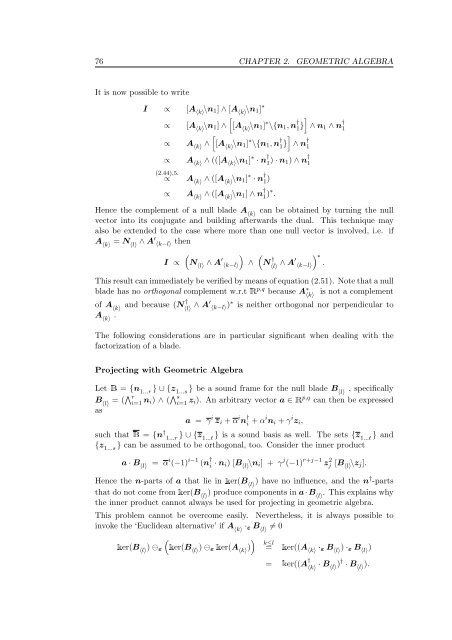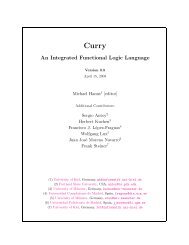Conformal Geometric Algebra in Stochastic Optimization Problems ...
Conformal Geometric Algebra in Stochastic Optimization Problems ...
Conformal Geometric Algebra in Stochastic Optimization Problems ...
You also want an ePaper? Increase the reach of your titles
YUMPU automatically turns print PDFs into web optimized ePapers that Google loves.
76 CHAPTER 2. GEOMETRIC ALGEBRA<br />
It is now possible to write<br />
I ∝ [A 〈k〉 \n1] ∧ [A 〈k〉 \n1] ∗<br />
∝ [A 〈k〉 \n1] ∧<br />
∝ A 〈k〉 ∧<br />
�<br />
[A 〈k〉 \n1] ∗ \{n1, n †<br />
�<br />
[A 〈k〉 \n1] ∗ \{n1, n †<br />
1 }<br />
�<br />
1 }<br />
�<br />
∧ n †<br />
1<br />
∝ A 〈k〉 ∧ (([A 〈k〉 \n1] ∗ · n †<br />
1 ) · n1) ∧ n †<br />
1<br />
(2.44),5.<br />
∝ A 〈k〉 ∧ ([A 〈k〉 \n1] ∗ · n †<br />
1 )<br />
∝ A 〈k〉 ∧ ([A 〈k〉 \n1] ∧ n †<br />
1 )∗ .<br />
∧ n1 ∧ n †<br />
1<br />
Hence the complement of a null blade A 〈k〉 can be obta<strong>in</strong>ed by turn<strong>in</strong>g the null<br />
vector <strong>in</strong>to its conjugate and build<strong>in</strong>g afterwards the dual. This technique may<br />
also be extended to the case where more than one null vector is <strong>in</strong>volved, i.e. if<br />
A 〈k〉 = N 〈l〉 ∧ A ′ 〈k−l〉 then<br />
I ∝<br />
�<br />
N 〈l〉 ∧ A ′ �<br />
〈k−l〉<br />
∧<br />
�<br />
N †<br />
〈l〉 ∧ A′ �∗ 〈k−l〉 .<br />
This result can immediately be verified by means of equation (2.51). Note that a null<br />
blade has no orthogonal complement w.r.t � p,q because A ∗ 〈k〉 is not a complement<br />
of A 〈k〉 and because (N †<br />
〈l〉 ∧ A′ 〈k−l〉) ∗ is neither orthogonal nor perpendicular to<br />
A 〈k〉 .<br />
The follow<strong>in</strong>g considerations are <strong>in</strong> particular significant when deal<strong>in</strong>g with the<br />
factorization of a blade.<br />
Project<strong>in</strong>g with <strong>Geometric</strong> <strong>Algebra</strong><br />
Let � = {n1...r } ∪ {z1...s } be a sound frame for the null blade B 〈l〉 , specifically<br />
B 〈l〉 = ( �r i=1 ni) ∧ ( �s i=1 zi). An arbitrary vector a ∈ � p,q can then be expressed<br />
as<br />
a = γ i zi + α i n †<br />
i + α<strong>in</strong>i + γ i zi,<br />
such that � = {n † 1...r } ∪ {z1...t } is a sound basis as well. The sets {z1...t } and<br />
{z1...s } can be assumed to be orthogonal, too. Consider the <strong>in</strong>ner product<br />
a · B 〈l〉 = α i (−1) i−1 (n †<br />
i · ni) [B 〈l〉 \ni] + γ j (−1) r+j−1 z 2 j [B 〈l〉 \zj].<br />
Hence the n-parts of a that lie <strong>in</strong> �er(B 〈l〉 ) have no <strong>in</strong>fluence, and the n † -parts<br />
that do not come from �er(B 〈l〉 ) produce components <strong>in</strong> a ·B 〈l〉 . This expla<strong>in</strong>s why<br />
the <strong>in</strong>ner product cannot always be used for project<strong>in</strong>g <strong>in</strong> geometric algebra.<br />
This problem cannot be overcome easily. Nevertheless, it is always possible to<br />
<strong>in</strong>voke the ‘Euclidean alternative’ if A 〈k〉 ·ε B 〈l〉 �= 0<br />
�er(B 〈l〉 ) ⊖ε<br />
�<br />
�<br />
k≤l<br />
�er(B 〈l〉 ) ⊖ε �er(A 〈k〉 ) = �er((A〈k〉 ·ε B 〈l〉 ) ·ε B 〈l〉 )<br />
= �er((A †<br />
〈k〉 · B 〈l〉 )† · B 〈l〉 ).
















